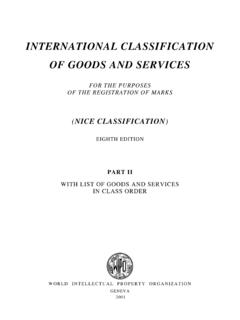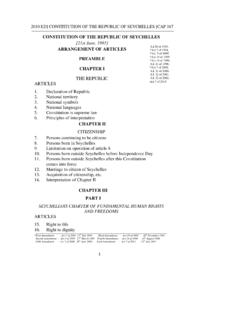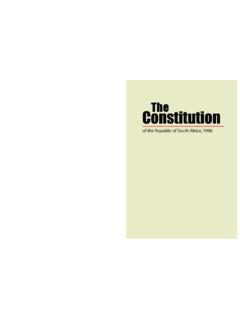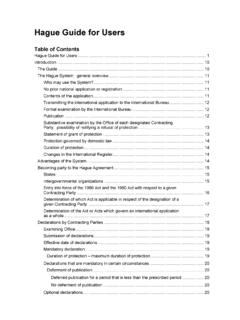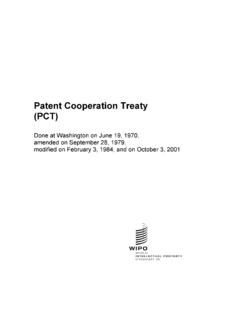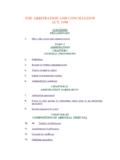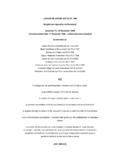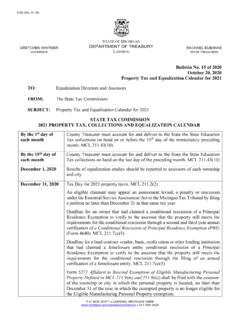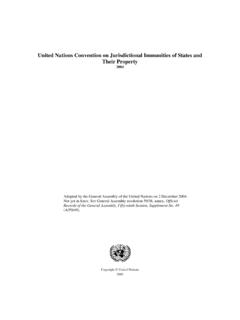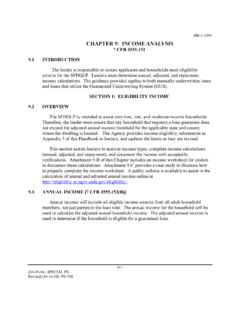Transcription of Protect and Promote Your Culture - WIPO
1 Protect and Promote your CultureA Practical Guide to Intellectual property for Indigenous Peoples and Local CommunitiesProtect and Promote your Culture A Practical Guide to Intellectual property for Indigenous Peoples and Local CommunitiesThis is a publication of wipo s Traditional Knowledge Division. The lead authors were Bego a Venero Aguirre and Hai-Yuean Tualima, wipo Indigenous Fellow from February 2015 until February 2017, with support and comments from Wend Wendland, Guriqbal Singh Jaiya, Kiri Toki, Daphn Zografos-Johnsson, Alice Manero, Atif Bhatti, Tim Engelhardt, Marina Foschi, Violeta Ghetu, Tomoko Miyamoto, Marie Paule Rizo and Michele Woods. The text was edited by Toby and Promote your CultureA Practical Guide to Intellectual property for Indigenous Peoples and Local Communities wipo , 2017 World Intellectual property Organization 34, chemin des Colombettes, Box 18 CH-1211 Geneva 20, SwitzerlandAttribution IGO license (CC BY IGO)Printed in SwitzerlandThe user is allowed to reproduce, distribute, adapt, translate and publicly perform this publication, including for commer-cial purposes, without explicit permission, provided that the content is accompanied by an acknowledgement that wipo is the source and that it is clearly indicated if changes were made to the original citation:World Intellectual property Organization ( wipo ) (2017) Protect and Promote your Culture .
2 A Practical Guide to Intellectual property for Indigenous Peoples and Local Communities. wipo : should not carry any official emblem or logo, unless they have been approved and validated by wipo . Please contact us via the wipo website to obtain permission. For any derivative work, please include the following dis-claimer: The Secretariat of wipo assumes no liability or responsibility with regard to the transformation or translation of the original content. When content published by wipo , such as images, graphics, trademarks or logos, is attributed to a third party, the user of such content is solely responsible for clearing the rights with the right holder(s).To view a copy of this license, please visit designations employed and the presentation of material throughout this publication do not imply the expression of any opinion whatsoever on the part of wipo concerning the legal status of any country, territory or area or of its authorities, or concerning the delimitation of its frontiers or publication is not intended to reflect the views of the Member States or the wipo Secretariat.
3 The mention of specific companies or products of manufac-turers does not imply that they are endorsed or recommended by wipo in preference to others of a similar nature that are not mentioned. Cover image credits: Extract from Munupi Mural by Susan Wanji Wanji / Susan Wanji Wanji, Munupi Arts and Crafts; Stock image of rooibos tea: iStock/ mission of the World Intellectual property Organization is to create a fair and balanced global intellectual property system that works for everyone, including indigenous peoples and local the world, indigenous peoples and local communities have developed a wealth of traditional knowledge and traditional cultural expressions which they rightly wish to Protect and Promote . Yet few have used the intellectual prop-erty system to do so. And, unfortunately, their knowledge systems and cultural expressions have sometimes been used without their authorization and they have not shared in the benefits of such use.
4 The intellectual property system does not provide solutions to all the chal-lenges that indigenous peoples and lo-cal communities face concerning their traditional knowledge and traditional cultural expressions. However, it does include tools that can be used either to directly Protect traditional knowledge and traditional cultural expressions or to prevent their short, accessible and practical guide aims to help indigenous peoples and lo-cal communities better understand the intellectual property system and make in-formed decisions about when and how to use intellectual property tools to Protect and Promote their traditional knowledge and traditional cultural expressions. It includes many examples where indigenous peoples and local communities have done exactly that. As these examples also show, the intellectual property system, while not perfect, includes mechanisms to modify or revoke rights that were granted to creations and innovations not eligible for is my hope that this publication will contribute to the empowerment of in-digenous peoples and local communities, will inspire them to continue innovating and creating, and will encourage them to make strategic use of and benefit from the intellectual property system.
5 Francis GurryDirector General4 Table of ContentsIntroduction 7 Traditional knowledge, traditional cultural expressions and intellectual property 9 Key features of intellectual property protection 13 Balancing intellectual property rights and the public domain 15 How do intellectual property rights work? 15 Why are there different types of intellectual property rights? In what ways do they differ? 16 Why do you need to know about intellectual property ? 18 An example from South Africa: rooibos 19 An example from Peru: SUMAQ SONQO 20 Where to find out more about intellectual property 21 Copyright 23 What does copyright Protect ? 24 How does copyright work? What kind of protection does it offer?
6 25 Copyright and traditional cultural expressions 26 An example from Ghana: Kente 27 An example from Australia: Dreaming stories 28 Where to find out more about copyright 29 Patents 31 What do patents Protect ? 32 How do patents work? What kind of protection do they offer? 33 Patents and traditional knowledge 34 An example from India: Myristica fragrans 35 An example from Australia: the crocodile hunter 36 Another example from Australia: a collaborative research project leads to a patent 37 Where to find out more about patents 38 Trademark s 39 What do trademarks Protect ?
7 40 How do trademarks work? What kind of protection does a mark offer? 40 COWICHAN: a certification mark from Canada 41 Collective and certification marks 42 An example from Kenya: Taita baskets 43 Examples from New Zealand and from the Andean Community 44 Where to find out more about trademarks 45 Geographical Indications 47 What are geographical indications and why should they be protected? 48 How are geographical indications protected? 48 5 An example from Ecuador: the Montecristi straw hat 49 Geographical indications, traditional knowledge and traditional cultural expressions 50 Where to find out more about geographical indications 50 Industrial Designs 51 What do industrial designs Protect ?
8 52 How does industrial design protection work? What kind of protection do industrial designs offer? 52 Industrial designs and traditional cultural expressions 52 A hypothetical example: designing didgeridoos 53 Where to find out more about industrial designs 54 Protection against Unfair Competition 55 Why Protect against unfair competition? 56 What kind of protection against unfair competition may be available? 56 Using laws on unfair competition to Protect traditional knowledge and traditional cultural expressions 56 An example from Australia: misleading or deceptive labels 57 Another example from Australia: preventing false representation 57 Where to find out more about protection against unfair competition 58 Trade Secrets 59 What are trade secrets and why are they protected?
9 60 How does trade secrets protection work? What kind of protection does it offer? 60 An example from Australia: the Pitjantjatjara Council s sacred secret 61 Trade secrets and traditional knowledge 62 Where to find out more about trade secrets 62 Table 1: What is protected by the different categories of intellectual property ? 17 Table 2: Summary of intellectual property tools 63 Glossary 64 Introduction8 Protect and Promote your CultureAn Aboriginal community in Australia has gone into partnership with a university to develop painkilling drugs based on herbal treatments known to the community for many years. They have protected the new drugs through a farmers in Peru grow a par-ticular type of potato which is famous for its quality and taste.
10 They have started using a trademark to help Promote their potatoes, helping them secure higher law in Ghana has been re-formed to stop companies copying the distinctive fabric designs developed by certain ethnic are just three examples of the ways in which indigenous peoples and local communities can benefit from the intel-lectual property is not to suggest that intellectual property law meets all the needs of in-digenous peoples and local communities. But, if strategically used, the intellectual property system can be crucial. By using the intellectual property system, you may be able to prevent other people, compa-nies or organizations from exploiting your traditional knowledge and Culture without your permission (also known as misappropriation). And you may also be able to maximize the economic value of products and services that you develop based on your traditional property law can help you to Protect and Promote your culture9A Practical Guide to Intellectual property for Indigenous Peoples and Local CommunitiesSo it is very important to understand intellectual property and the intellectual property system.


